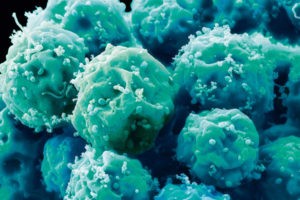“We have known for some time that influenza and cold epidemics tend to be worse in the winter when temperatures are cooler. Also, mice living at higher temperatures suffer less from inflammation and cancer (MM?)…”
No one thinks of sauna as a cancer killing therapy…
I was diagnosed with multiple myeloma, an incurable blood cancer, in early 1994. Conventional therapies including surgery, radiation, induction therapy and an autologous stem cell transplant did little for me beyond short, long-term and late stage side effects. I underwent a non-toxic, alternative therapy called antineoplaston therapy from 11/97-4/99.
If we’re diagnosed with an incurable cancer, we all look for the ultimate multiple myeloma therapy. Could inflammation be the key to curing cancer? Okay, that’s a big statement but hear me out.

By April of 1999 I was in complete remission from multiple myeloma. Don’t misunderstand me, achieving complete remission after being told I was end-stage was wonderful.
However after living in complete remission from multiple myeloma since early 1999 (today is 2/8/2020) I’m wondering why I haven’t relapsed. I take an SPEP test annually and my serum freelight chains are always in the “normal” range.
What am I doing differently that is allowing me to remain in complete remission when all other MMers relapse? Could it be the research linked and excerpted below? Could WBH aka sauna be the ultimate multiple myeloma therapy?
Like most normal people my body temperature is 37 degrees celsius which is 98.6 degrees fahrenheit. 2-3 times a week I’ve take a sauna. Usually 190-200 degrees, usually 15-20 minutes.
According to the article linked below, if I can increase my internal temperature “the NF-κB clock speeds up.”
The second study below talks about whole-body hyperthermia causing the body to produce manganese superoxide dismutase (Mn-SOD) which is a “radical scavanger.” I think my frequent whole-body hyperthermia sessions fight colds, flus and cancer.
Other benefits of whole-body hyperthermia (my sauna)- sweat our heavy metals, WBH is heart healthy and WBH is an integrative cancer therapy.
- Blood, urine, and sweat (BUS) study: monitoring and elimination of bioaccumulated toxic elements.
- Sauna: The Hottest Therapy for Heart Disease
- Basic principles in hyperthermic tumor therapy.
Have you been diagnosed with multiple myeloma? To learn about evidence-based, non-toxic multiple myeloma therapy, scroll down the page, post a question or comment and I will reply to you ASAP.
Whole-body Hyperthermia- the ultimate Myeloma Lifestyle Therapy
Have you had an ASCT? Have you developed side effects?
Thank you,
David Emerson
- MM Survivor
- MM Cancer Coach
- Director PeopleBeatingCancer
Recommended Reading:
“The hotter our body temperature, the more our bodies speed up a key defence system that fights against tumours, wounds or infections, new research by a multidisciplinary team of mathematicians and biologists from the Universities of Warwick and Manchester has found.
The researchers have demonstrated that small rises in temperature (such as during a fever) speed up the speed of a cellular ‘clock’ that controls the response to infections — and this new understanding could lead to more effective and fast-working drugs which target a key protein involved in this process.
Biologists found that inflammatory signals activate ‘Nuclear Factor kappa B’ (NF-κB) proteins to start a ‘clock’ ticking, in which NF-κB proteins move backwards and forwards into and out of the cell nucleus, where they switch genes on and off.
This allows cells to respond to a tumour, wound or infection. When NF-κB is uncontrolled, it is associated with inflammatory diseases, such as Crohn’s disease, psoriasis and rheumatoid arthritis.
At a body temperature of 34 degrees, the NF-κB clock slows down. At higher temperatures than the normal 37 degree body temperature (such as in fever, 40 degrees), the NF-κB clock speeds up.
Mathematicians at the University of Warwick’s Systems Biology Centre calculated how temperature increases make the cycle speed up.
They predicted that a protein called A20 — which is essential to avoid inflammatory disease — might be critically involved in this process. The experimentalists then removed A20 from cells and found that the NF-kB clock lost its sensitivity to increases in temperature…
While the activities of many NF-kB controlled genes were not affected by temperature, a key group of genes showed altered profiles at the different temperatures. These temperature sensitive genes included key inflammatory regulators and controllers of cell communication that can alter cell responses.
This study shows that temperature changes inflammation in cells and tissues in a biologically organised way and suggests that new drugs might more precisely change the inflammatory response by targeting the A20 protein.
Professor Mike White, lead biologist from the University of Manchester, said the study provides a possible explanation of how both environmental and body temperature affects our health:
“We have known for some time that influenza and cold epidemics tend to be worse in the winter when temperatures are cooler. Also, mice living at higher temperatures suffer less from inflammation and cancer. These changes may now be explained by altered immune responses at different temperatures.”
“Background—Hyperthermia increases cardiac tolerance to ischemia/reperfusion injury and activates manganese superoxide dismutase (Mn-SOD), an intrinsic radical scavenger, in myocardium in a biphasic manner. Tumor necrosis factor-α (TNF-α) and interleukin-1β (IL-1β) induced a biphasic cardioprotection that corresponded to the activation of Mn-SOD…
“Extensive studies on manganese superoxide dismutase (MnSOD) have demonstrated that MnSOD plays a critical role in the development and progression of cancer. Many human cancer cells harbor low levels of MnSOD proteins and enzymatic activity, whereas some cancer cells possess high levels of MnSOD expression and activity. This apparent variation in MnSOD level among cancer cells suggests that differential regulation of MnSOD exists in cancer cells and that this regulation may be linked to the type and stage of cancer development...”
APPIP ERROR: amazonproducts[
AccessDeniedAwsUsers|The Access Key Id AKIAJAJ37JVNL7OUU4CA is not enabled for accessing this version of Product Advertising API. Please migrate your credentials as referred here https://webservices.amazon.com/paapi5/documentation/migrating-your-product-advertising-api-account-from-your-aws-account.html.
]




